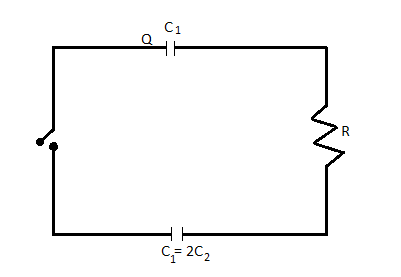Question
Question: Two capacitors \[{C_1}\] and \({C_2} = 2{C_1}\) are connected in a circuit with a switch between the...
Two capacitors C1 and C2=2C1 are connected in a circuit with a switch between them as shown in the figure. Initially the switch is open and C1 holds charge Q . The switch is closed. At steady state, the charge on the each capacitor will be:

(A) Q,2Q
(B) 3Q,32Q
(C) 23Q,3Q
(D) 32Q,34Q
Solution
For finding the charges on each plate of capacitor, first we find the common voltage of the circuit. After getting common voltage, we calculate charge on each plate of capacitor using the relationship between capacitance, voltage and charge.
Useful formula:
Relationship between voltage, capacitance and charge is given by the following formula:
⇒Q=CV
Where, Q is charged, C is capacitance and V is voltage of the circuit.
Complete step by step solution:
Given that capacitor C1 , C2 , resistance R and a switch in the circuit in the figure. Initially the switch is open and the capacitor C1holds Q charge. When the switch is closed. At steady state, the charge distributed on each plate but voltage across the circuit is the same.
We know that charge is equal to the product of capacitance and voltage.
⇒Q=CV
So, Voltage can be written as from the above formula
⇒V=CQ
Common voltage can be calculated putting the value of total charge and total capacitance on above formula and we get,
⇒V=C1+C2Q
We know that C2=2C1 , putting this value on above formula and we get,
⇒V=C1+2C1Q
After simplify we get,
⇒V=3C1Q ⋯⋯⋯(1)
Let charge on plate of capacitor C1 is Q1 and charge on plate of capacitor C2 is Q2 , then total charge Q will be equal to sum of charge Q1and Q2 .
⇒Q=Q1+Q2⋯⋯⋯(2)
Now, Charge Q1 is calculated using the formula,
⇒Q1=C1×V
Putting value of voltage V from the equation (1) on the above formula and we get,
⇒Q1=C1×3C1Q
After simplification we get,
⇒Q1=3Q
Putting value of Q1 in the equation (2) then we get,
⇒Q=3Q+Q2
Take 3Q into other side to get value of Q2
⇒Q2=Q−3Q
After simplify we get,
⇒Q2=32Q
Therefore, Charge on plate of capacitor C1 is 3Q and charge on plate of capacitor C2 is 32Q .
Hence, option (B) is correct.
Note: Charge is measured in Coulomb, voltage is measured in volt, resistance is measured in Ohm, and capacitance is measured in faraday.
